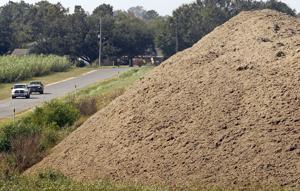
A few years ago, Mary Guarisco started noticing mountains of bagasse, the crop residue left after sugarcane is crushed, piling up at Alma Plantation down the road from her house.
“They’ve almost filled up just acres of land with this refuse,” she said. “Everybody is so curious about it here.”
Guarisco and her neighbors weren’t upset about the piles, but they were bewildered by their growth. At 87 years old, she said she’s never seen anything like it, even though she grew up around sugarcane.
It’s not just Guarisco’s imagination. The bagasse piles are bigger than ever before.
“It seems like piles are growing larger because Alma is grinding more cane,” said Kenneth Gravois, sugarcane specialist at LSU’s Sugar Research Station. “Pointe Coupee is now the number one sugarcane parish in the state.”
There’s more sugarcane being grown, but fewer mills.
“There used to be a lot of small piles scattered around in the 24 sugar producing parishes,” said Jim Simon, manager of the American Sugar Cane League. “Now there are fewer mills, so each mill takes in more sugarcane.”
Instead of grinding 1.4 million tons of cane, the mills are grinding up to two million tons.
“There’s just more excess bagasse to deal with,” Gravois said.
More acres of sugarcane mean longer grinding seasons, which contributes to piles growing faster. But mills are also more energy efficient than they used to be, so they end up with more excess, said Charles Schudmak, chief operating officer of Cora Texas Manufacturing Co.
Plant power
Bagasse is a pain to deal with. It’s light and fluffy and hard to transport. It’s expensive to move. And as piles grow, they take up space where more sugarcane could grow.
Sugarcane farmers and mills across Louisiana have been searching for ways to get rid of bagasse for decades.
For years, mills have used bagasse as a power source.
“By far the biggest use is to burn it in the mill as a green fuel,” said Gravois. “Mills use very little fossil fuel inside the factory. So when all that juice gets extracted out of the pulp, the majority of the bagasse ends up going to the boilers.”
The boilers create steam, which powers moving equipment and electricity generators.
Simon, at the American Sugar Cane League, said all 11 sugar mills in Louisiana use bagasse as fuel.
“We are in essence biorefineries. We grow our own energy,” he said.
But not all of it can be used. Gravois said roughly 10 percent carries over and gets stacked up into piles, like the one he calls “Mt. Alma.”
“All the mills have the same issue. There’s always a bit of excess out there,” he said.
Agricultural scientists have put a lot money and brainpower finding uses for that excess.
“Over the years, there have been hundreds of millions of dollars spent on trying to find alternative uses for bagasse. It is a very difficult product to deal with,” said Simon. “At one point in our history we made paper with it, additionally we made ceiling tiles with it. But they found other sources that are cheaper to utilize than bagasse, easier to handle.”
Fuel Pellets & Biochar
American Biocarbon runs a pilot plant on the Cora Texas mill property, where it makes fuel pellets, a coal alternative used in industrial heating plants that are transitioning away from fossil fuels. It also makes biochar, which is placed under sugarcane roots and which the company estimates can increase yields by 30 percent per acre.
“You have a drought cycle and a wet cycle,” said Erwin Bogner, co-founder and chief technology officer at American Biocarbon. “When you put biochar in the ground it absorbs water and fertilizer because it has a high absorption power, so then when the drought comes, the sugarcane root has more water for a longer time.”
Gravois said biochar could increase soil organic matter over the long term.
“A soil is a living entity, not just inert, so organic matter is important for all the soil microbes, bacteria, fungi,” he said. “The best place to put an agricultural waste is where you found it, out in the field.”
American BioCarbon is in the midst of building a larger production facility which it says will eliminate all of Cora Texas’s bagasse.
“In three years, those piles will be gone. It’s gonna disappear fast,” said Schudmak.
Carbon Capture Sequestration
Another potential for bagasse could be biomass slurry injection. A group of LSU professors has been researching how to take bagasse, grind it into a slurry, and inject it deep into the ground.
Plants take in carbon from the atmosphere through photosynthesis. Most of the carbon becomes part of the plant’s mass and helps it grow, and some of it goes into the soil. The plant essentially becomes a carbon sink until it dies, then carbon is released back into the atmosphere during decomposition.
“Basically, what this project does is it doesn’t allow for the decomposition stage,” said Brian Snyder, one of the Department of Environmental Sciences professors working on the project.
Biomass slurry injection differs from more controversial carbon capture projects across Louisiana in a key way: projects are taking carbon from an emissions source like a smokestack, whereas this process takes carbon from the atmosphere. The process could have a huge impact globally.
“We have to remove CO2 from the atmosphere to come even close to the goals of the Paris Agreement,” Snyder said, referencing a global pact to try and stop catastrophic impacts of climate change. “This process can’t do all of that, but it could contribute.”
Additional uses
These technologies are a good start, producers say, but there’s more research being done on bagasse all the time.
Schudmak at Cora Texas said some researchers are looking into creating second-generation ethanol, for example. AMS Compostable, a company in Florida, grinds the bagasse into a pulp and makes paper plates and food storage containers.
Those at the mills are anxious for a solution.
“It sits there. It decomposes very, very slowly. It’s a product that we’re trying to figure out a use for, because it’s expensive to handle it, to move it around,” said Simon.




Leave a Reply